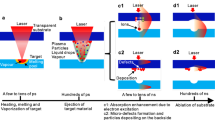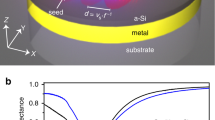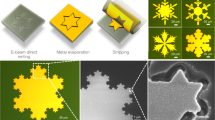Abstract
Laser cutting of semiconductor wafers and transparent dielectrics has become a dominant process in manufacturing industries, encompassing a wide range of applications from display panels to microelectronic chips. Constrained by the diffraction limit of the beam width and the longitudinal extent of the laser focus, a trade-off between the cutting accuracy and the aspect ratio is inherent to conventional laser processing, with the accuracy typically approaching one micrometre and the aspect ratio of the order of 100. Here we propose a method to circumvent this limitation. Our method exploits a mechanism of back-scattering interference crawling in which the incident beam interferes with light that is back-scattered by laser-induced nanoseeds, creating a positive feedback loop. This mechanism ensures both homogenization of longitudinal energy deposition and confinement of lateral subwavelength light during laser–matter interactions. We achieve cutting widths in the range of tens of nanometres with aspect ratios ranging from 1,000 to 10,000. We refer to this technique as ‘super-stealth dicing’ and we validate it through numerical simulations. The technique can be applied to various transparent functional solids, such as glass, laser crystals and ferroelectric and semiconductor materials, thus promising enhanced precision for future advanced laser dicing, patterning and drilling.
This is a preview of subscription content, access via your institution
Access options
Access Nature and 54 other Nature Portfolio journals
Get Nature+, our best-value online-access subscription
$29.99 / 30 days
cancel any time
Subscribe to this journal
Receive 12 print issues and online access
$209.00 per year
only $17.42 per issue
Buy this article
- Purchase on Springer Link
- Instant access to full article PDF
Prices may be subject to local taxes which are calculated during checkout





Similar content being viewed by others
Data availability
The data that support the findings of this study are available from the corresponding authors upon reasonable requests.
References
Adams, C. M. & Hardway, G. A. Fundamentals of laser beam machining and drilling. IEEE Trans. Ind. Gen. Appl. 2, 90–96 (1965).
Kerse, C. et al. Ablation-cooled material removal with ultrafast bursts of pulses. Nature 537, 84–88 (2016).
Park, M., Gu, Y., Mao, X., Grigoropoulos, C. P. & Zorba, V. Mechanisms of ultrafast GHz burst fs laser ablation. Sci. Adv. 9, eadf6397 (2023).
Öktem, B. et al. Nonlinear laser lithography for indefinitely large-area nanostructuring with femtosecond pulses. Nat. Photonics 7, 897–901 (2013).
Tokel, O. et al. In-chip microstructures and photonic devices fabricated by nonlinear laser lithography deep inside silicon. Nat. Photonics 11, 639–645 (2017).
Kumagai, M. et al. Advanced dicing technology for semiconductor wafer—stealth dicing. IEEE Trans. Semicond. Manuf. 20, 259–265 (2007).
Malinauskas, M. et al. Ultrafast laser processing of materials: from science to industry. Light Sci. Appl. 5, e16133 (2016).
Novotny, L. & Hecht, B. Principles of Nano-Optics (Cambridge Univ. Press, 2012).
Indebetouw, G. Nondiffracting optical fields: some remarks on their analysis and synthesis. J. Opt. Soc. Am. A 6, 150–152 (1989).
Durnin, J., Miceli, J. J. & Eberly, J. H. Diffraction-free beams. Phys. Rev. Lett. 58, 1499–1501 (1987).
Bialynicki-Birula, I. & Bialynicka-Birula, Z. Heisenberg uncertainty relations for photons. Phys. Rev. A 86, 022118 (2012).
McCutchen, C. W. Generalized aperture and the three-dimensional diffraction image. J. Opt. Soc. Am. 54, 240–244 (1964).
Betzig, E. & Trautman, J. K. Near-field optics: microscopy, spectroscopy, and surface modification beyond the diffraction limit. Science 257, 189–195 (1992).
Li, Z.-Z. et al. O-FIB: far-field-induced near-field breakdown for direct nanowriting in an atmospheric environment. Light Sci. Appl. 9, 41 (2020).
Yan, Z., Gao, J., Beresna, M. & Zhang, J. Near-field mediated 40 nm in-volume glass fabrication by femtosecond laser. Adv. Opt. Mater. 10, 2101676 (2022).
Lei, Y. et al. High speed ultrafast laser anisotropic nanostructuring by energy deposition control via near-field enhancement. Optica 8, 1365–1371 (2021).
Plech, A., Leiderer, P. & Boneberg, J. Femtosecond laser near field ablation. Laser Photonics Rev. 3, 435–451 (2009).
Wu, H. et al. Photonic nanolaser with extreme optical field confinement. Phys. Rev. Lett. 129, 013902 (2022).
Liu, H., Lin, W. & Hong, M. Hybrid laser precision engineering of transparent hard materials: challenges, solutions and applications. Light Sci. Appl. 10, 162 (2021).
Bhuyan, M. K. et al. Ultrafast laser nanostructuring in bulk silica, a ‘slow’ microexplosion. Optica 4, 951–958 (2017).
Jiang, L., Wang, A.-D., Li, B., Cui, T.-H. & Lu, Y.-F. Electrons dynamics control by shaping femtosecond laser pulses in micro/nanofabrication: modeling, method, measurement and application. Light Sci. Appl. 7, 17134 (2018).
Chanal, M. et al. Crossing the threshold of ultrafast laser writing in bulk silicon. Nat. Commun. 8, 773 (2017).
Wang, A. et al. Burst mode enabled ultrafast laser inscription inside gallium arsenide. Int. J. Extrem. Manuf. 4, 045001 (2022).
Götte, N. et al. Temporal Airy pulses for controlled high aspect ratio nanomachining of dielectrics. Optica 3, 389–395 (2016).
Liu, X., Clady, R., Grojo, R., Utéza, O. & Sanner, N. Engraving depth-controlled nanohole arrays on fused silica by direct short-pulse laser ablation. Adv. Mater. Interfaces 10, 2202189 (2023).
Juodkazis, S. et al. Laser-induced microexplosion confined in the bulk of a sapphire crystal: evidence of multimegabar pressures. Phys. Rev. Lett. 96, 166101 (2006).
Bellouard, Y. et al. Stress-state manipulation in fused silica via femtosecond laser irradiation. Optica 3, 1285–1293 (2016).
Tan, D., Zhang, B. & Qiu, J. Ultrafast laser direct writing in glass: thermal accumulation engineering and applications. Laser Photonics Rev. 15, 2000455 (2021).
Flamm, D. et al. Structured light for ultrafast laser micro- and nanoprocessing. Opt. Eng. 60, 025105 (2021).
Salter, P. S. & Booth, M. J. Adaptive optics in laser processing. Light Sci. Appl. 8, 110 (2019).
Meyer, R. et al. Single-shot ultrafast laser processing of high-aspect-ratio nanochannels using elliptical Bessel beams. Opt. Lett. 42, 4307–4310 (2017).
Velpula, P. K. et al. Spatio-temporal dynamics in nondiffractive Bessel ultrafast laser nanoscale volume structuring. Laser Photonics Rev. 10, 230–244 (2016).
Mahmoud Aghdami, K., Rahnama, A., Ertorer, E. & Herman, P. R. Laser nano-filament explosion for enabling open-grating sensing in optical fibre. Nat. Commun. 12, 6344 (2021).
Couairon, A. & Mysyrowicz, A. Femtosecond filamentation in transparent media. Phys. Rep. 441, 47–189 (2007).
Motoyoshi, M. Through-silicon via (TSV). Proc. IEEE 97, 43–48 (2009).
Sugioka, K. & Cheng, Y. Ultrafast lasers—reliable tools for advanced materials processing. Light Sci. Appl. 3, e149 (2014).
Kawata, S., Sun, H.-B., Tanaka, T. & Takada, K. Finer features for functional microdevices. Nature 412, 697–698 (2001).
Lin, Z., Liu, H., Ji, L., Lin, W. & Hong, M. Realization of ~10 nm features on semiconductor surfaces via femtosecond laser direct patterning in far field and in ambient air. Nano Lett. 20, 4947–4952 (2020).
Rapp, L. et al. High aspect ratio micro-explosions in the bulk of sapphire generated by femtosecond Bessel beams. Sci. Rep. 6, 34286 (2016).
Li, Z., Allegre, O. & Li, L. Realising high aspect ratio 10 nm feature size in laser materials processing in air at 800 nm wavelength in the far-field by creating a high purity longitudinal light field at focus. Light Sci. Appl. 11, 339 (2022).
Meyer, R. et al. Extremely high-aspect-ratio ultrafast Bessel beam generation and stealth dicing of multi-millimeter thick glass. Appl. Phys. Lett. 114, 201105 (2019).
Bellouard, Y., Said, A., Dugan, M. & Bado, P. Fabrication of high-aspect ratio, micro-fluidic channels and tunnels using femtosecond laser pulses and chemical etching. Opt. Express 12, 2120–2129 (2004).
Ródenas, A. et al. Three-dimensional femtosecond laser nanolithography of crystals. Nat. Photonics 13, 105–109 (2019).
Meyer, R., Giust, R., Jacquot, M., Dudley, J. M. & Courvoisier, F. Submicron-quality cleaving of glass with elliptical ultrafast Bessel beams. Appl. Phys. Lett. 111, 231108 (2017).
Stoian, R. Volume photoinscription of glasses: three-dimensional micro- and nanostructuring with ultrashort laser pulses. Appl. Phys. A 126, 438 (2020).
Lancry, M. et al. Ultrafast nanoporous silica formation driven by femtosecond laser irradiation. Laser Photonics Rev. 7, 953–962 (2013).
Xu, Q., Almeida, V. R., Panepucci, R. R. & Lipson, M. Experimental demonstration of guiding and confining light in nanometer-size low-refractive-index material. Opt. Lett. 29, 1626–1628 (2004).
Hentschel, M. et al. Dielectric Mie voids: confining light in air. Light Sci. Appl. 12, 3 (2023).
Zhang, J. et al. Ultra-wide bandgap semiconductor Ga2O3 power diodes. Nat. Commun. 13, 3900 (2022).
Liang, Z., Wu, J., Cui, Y., Sun, H. & Ning, C.-Z. Self-optimized single-nanowire photoluminescence thermometry. Light Sci. Appl. 12, 36 (2023).
Sander, T. H. et al. Magnetoencephalography with a chip-scale atomic magnetometer. Biomed. Opt. Express 3, 981–990 (2012).
Delgoffe, A., Nazir, S., Hakobyan, S., Hönninger, C. & Bellouard, Y. All-glass miniature GHz repetition rate femtosecond laser cavity. Optica 10, 1269–1279 (2023).
Rahim, K. & Mian, A. A review on laser processing in electronic and MEMS packaging. J. Electron. Packag. 139, 030801 (2017).
Sugioka, K. et al. Femtosecond laser 3D micromachining: a powerful tool for the fabrication of microfluidic, optofluidic, and electrofluidic devices based on glass. Lab Chip 14, 3447–3458 (2014).
Chambonneau, M. et al. In-volume laser direct writing of silicon—challenges and opportunities. Laser Photonics Rev. 15, 2100140 (2021).
Li, L., Kong, W. & Chen, F. Femtosecond laser-inscribed optical waveguides in dielectric crystals: a concise review and recent advances. Adv. Photonics 4, 024002 (2022).
Buschlinger, R., Nolte, S. & Peschel, U. Self-organized pattern formation in laser-induced multiphoton ionization. Phys. Rev. B 89, 184306 (2014).
Déziel, J.-L., Dubé, L. J. & Varin, C. Dynamical rate equation model for femtosecond laser-induced breakdown in dielectrics. Phys. Rev. B 104, 045201 (2021).
Garcia-Lechuga, M. et al. Simultaneous time–space resolved reflectivity and interferometric measurements of dielectrics excited with femtosecond laser pulses. Phys. Rev. B 95, 214114 (2017).
Acknowledgements
This work was supported in part by the National Natural Science Foundation of China (NSFC) under grant numbers 61825502, 61960206003, 61827826 and 62175086, the Key Research and Development Program of Shandong Province 2021CXGC010201 grant and the Natural Science Foundation of Jilin Province 20220101107JC grant. S.J. is grateful for the Australian Research Council DP240103231 grant. Z.-Z.L. would like to thank X.-B. Li, Y.-T. Huang, J.-C. Zhang and F. Yu for their valuable discussions. Z.-Z.L. thanks Z.-W. Ma and H.-L. Zhang for their assistance with the AFM measurements. Z.-Z.L. acknowledges Y. Lei and L.-Y. Zhao for their support in conducting the tests on sapphire waveplates.
Author information
Authors and Affiliations
Contributions
Z.-Z.L., H.F., L.W., S.J. and H.-B.S. conceived the experiments. Z.-Z.L., H.F., X.Z. and X.-J.Z. carried out the experiments. Z.-Z.L. and H.F. performed the numerical simulations. Z.-Z.L., L.W., H.F., Q.-D.C., S.J. and H.-B.S. analysed the data and calculated the results. X.-J.W. measured the fluorescence spectra. H.F., Y.-H.Y., Y.-S.X., Y.W. and Z.-Z.L. developed and improved the fabrication system. L.W., Q.-D.C., S.J. and H.-B.S. supervised the whole project. Z.-Z.L. and H.-B.S. wrote the initial draught, and all authors contributed to the final paper.
Corresponding authors
Ethics declarations
Competing interests
The authors declare no competing interests.
Peer review
Peer review information
Nature Photonics thanks Fatih Ilday and the other, anonymous, reviewer(s) for their contribution to the peer review of this work.
Additional information
Publisher’s note Springer Nature remains neutral with regard to jurisdictional claims in published maps and institutional affiliations.
Supplementary information
Supplementary Information
Supplementary Figs. 1–65, Sections 1–12, Tables 1–7 and refs. 1–73.
Supplementary Video 1
Schematic of the back-scattering interference crawling mechanism.
Supplementary Video 2
Schematic of polarization-controlled nanodicing via SSD.
Supplementary Video 3
Theoretical calculation of normalized optical intensity during back-scattering interference crawling.
Supplementary Video 4
Beam deflection of 90° achieved by total reflection from the bevelled edge of a YAG right-angle prism.
Supplementary Video 5
Optical microscope observation of a laser-cut fused silica microrod.
Rights and permissions
Springer Nature or its licensor (e.g. a society or other partner) holds exclusive rights to this article under a publishing agreement with the author(s) or other rightsholder(s); author self-archiving of the accepted manuscript version of this article is solely governed by the terms of such publishing agreement and applicable law.
About this article
Cite this article
Li, ZZ., Fan, H., Wang, L. et al. Super-stealth dicing of transparent solids with nanometric precision. Nat. Photon. (2024). https://doi.org/10.1038/s41566-024-01437-8
Received:
Accepted:
Published:
DOI: https://doi.org/10.1038/s41566-024-01437-8



